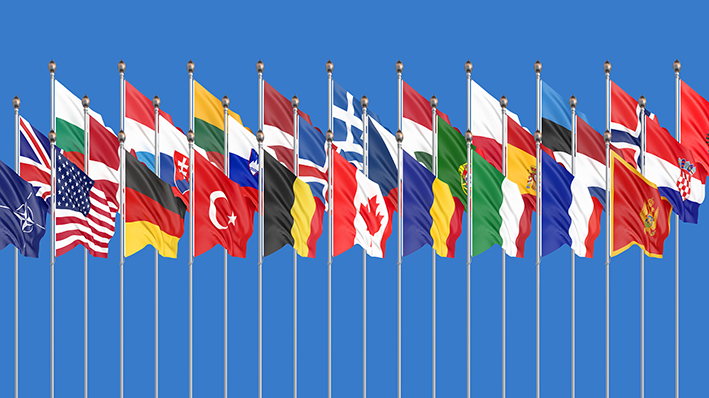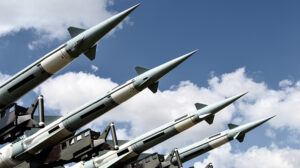
J_UK/Shutterstock.com
The North Atlantic Treaty Organization, NATO, has been the subject of countless twitter attacks on behalf of US President Donald Trump. Usually on the subject of European nation’s defense dues, Trump has displayed outright animosity towards the single strongest alliance in modern history. In return, European nations have rebuked the President for his aggressive, unfriendly manner. Many of which have turned a cold shoulder to the President’s U.S. foreign policy.
The very core of the transatlantic relationship between the US and its European allies has been under assault through twitter tirades, summit theatrics and even trade tariffs.
As NATO celebrates its 70th anniversary, many skeptics and pessimists see the erosion of transatlantic relations as an indication of the decline and potential dissolution of the powerful military and diplomatic treaty. However, as we enter the 2020’s, the animosity filled facade of NATO might not tell the full story.
DETERIORATION OF RELATIONS
President Trump’s critics will highlight the decay in European-American relations and lament him for ostracizing their most important allies. However, the deterioration of relations between the world and America has been a sentiment in the making far before Trump’s ascendance.
Ever since President George W. Bush’s decision to invade Iraq and depose Iraqi strongman Saddam Hussein, there has been a divide between the allies. While the nations had the appearance of solidarity, with handshakes and photo-ops, the diplomatic bond that had defined international relations in the 20th century, had been dealt a critical blow.
DIVERGENT VIEWS
The fundamental difference became whether Europe was to follow America blindly into wars around the globe. As Europeans became more America-skeptic and national finances constricted, the European willingness to engage in long, drawn out conflicts, particularly in the Middle East has faded.
The relationship has its issues no doubt and it seems as if the smiles and handshakes have been put on pause, especially with a confrontational, hostile Trumpian foreign policy. However, collaboration between Europe, Japan, Australia, Japan and the US has not faltered in the slightest. Rather, joint technological projects and military operations have become a mainstay in the alliance.
FUTURE UNITY
At this very moment, NATO allies are developing, perfecting and purchasing the Joint Strike Multi Role F-35 Lightning Fighter, championed by defense contractor, Lockheed Martin. This multi-trillion-dollar operation is yet another staple in the military bond between the allied nations.
The cooperation on technological advancements will be critical in the future, as highlighted by Jens Stoltenberg, the Secretary General of NATO.
With Russia and China racing against the US to produce improved ballistic missiles, 5th generation jet fighters and electronic/cyber warfare, the collaboration between allies has never been more critical. This collaboration, although maybe not reflected by the headlines or the tweets, is at its strongest in almost 30 years.
POST WARSAW PACT
Following the collapse of NATO’s military adversary, the Warsaw Pact as well as the USSR, the United States gradually withdrew personnel, weapons and its overall military presence from Europe. This was seen by many as America’s systematic abandoning of the European continent. But, considering current military cooperation, such an analysis would be very shallow.
Instead of merely “leaving”, the US handed over European security to native, European security forces. However, with the rise of an aggressive Russia and a nascent superpower in China, the US has recommitted tens of thousands of troops to the Eastern-most reaches of Europe as well as billions in defense equipment. Just some of the most recent American fortifications, a move to bolster the strength of NATO, prove the underlying strength of the organization.
PREPAREDNESS

3D Generator/Shutterstock.com
In 2019 U.S. Marines were deployed to Finland to participate in the Arrow-19 war games. Not only was it the largest simulation between the US and its Nordic ally, but the US stationed thousands of Marines on the Russian border. The U.S. built an SM-3 Missile System in Romania in 2013, and further bolstered the eastern ally in 2019 with a state-of-the art THAAD missile defense system.
NATO, for the first time in decades, ever since 2012, has achieved “Interim Capability” from the American Rammstein Air Force base in Germany. This, while seemingly insignificant, marks a major step in the total integration of NATO countries and their military operating systems.
The list of American military presence in NATO and Europe goes on and on, containing many billions of dollars in defense projects and over 320,00 active US military servicemen in Europe alone, which makes up almost 1/10 of all active military servicemen in Europe. Therefore, considering the massive presence of both American servicemen and defense technology, the argument that America has abandoned Europe seems shallow, misguided if not outright incorrect.
NATO A STABILIZER
Despite the deteriorating diplomatic ties between the U.S. and almost every other nation, NATO as a stabilizing joint military operation remains strong. The nature and origin of threats to Europe, the U.S. and its partners is constantly evolving, as highlighted by Jens Stoltenberg, and therefore the appearance of NATO will change.
While Americans may not be as present in Europe, due to a shift in threat level from Russia, NATO adapts itself to new threats such as those in the South China Sea and the Middle East.
NATO, in the 2020s, and for all the near future, will very likely remain the most dominant military organization in the world. Despite arguments over the “2% rule” (the share of national GDP required to be dedicated to defense), a major international realignment of allies is practically impossible. So long as the U.S. Military and European militaries, joined by “partners across the globe” such as Australia, Japan and South Korea maintain joint military operations and common defense goals, NATO will be steadfast.
About the Article
A glance at the U.S.’s future relationship with its NATO allies.



